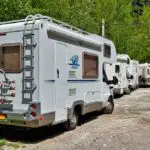Who knew there was a strategy to ensure you have a proper shower in an RV? Turns out, that is exactly the case if you spend any amount of time RVing. If you’re sick of listening to your wife complain about her freezing shower (or being said wife), you’re going to want to keep reading. Here are some RV shower tricks that make for a more successful — and warmer — experience.
How Long Will a Shower in an RV Last?
Let’s be real. The answer to this question is why you’re really here. I have seen some blog posts, supposedly written by RVers, saying that when you shower in an RV, you will get 2 to 3 minutes of hot water. I’m happy to report that these folks obviously don’t know what they are doing. With the proper strategy, I can get around 10-15 minute showers in the RV with hot water the whole time.
Generally speaking, the amount of hot water you get with an RV shower will depend on how big your hot water tank is. Smaller tanks won’t last as long as larger ones. Joel and I have a 6 gallon water heater in our RV which is pretty standard but there are larger options. Even still, I’m able to get a nice long shower.
What Else Impacts RV Shower Duration?
Another consideration for how long a shower in an RV lasts is how many people need to shower. After one person showers, if additional people need to shower, allow some time between showers. This will let the water can heat back up. If your RV has both propane and electric capabilities, turn on both to speed up reheating the water.
It is easy to tell when the water is hot when using propane to heat the water. You can hear when the propane kicks in and when it stops. After is stops you know that your 6 gallons are warm.
Another great option that makes your RV shower last longer is to get an on-demand water heater. This is a wonderful idea if you have full hookups, but it’s not ideal for boondocking. Many RVers complain that more water gets wasted while waiting for it to warm up when using a tankless water heater.
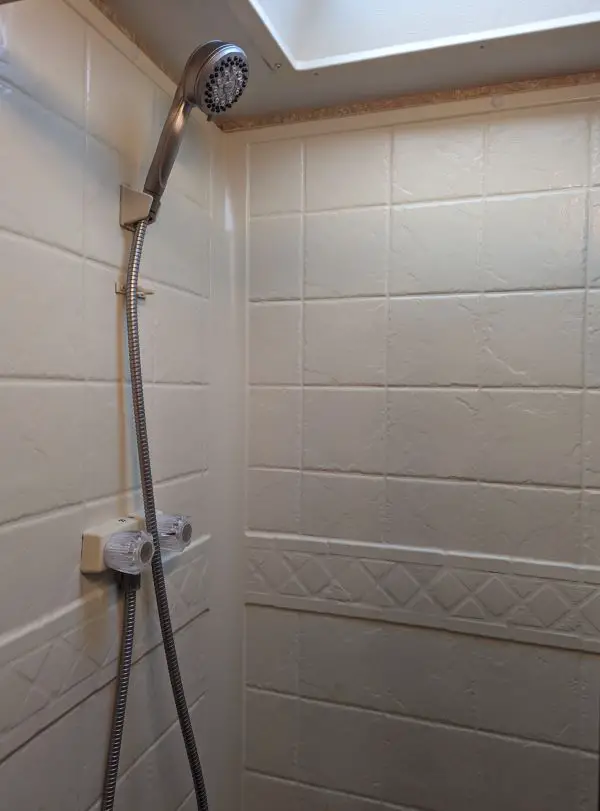
More on Tankless Water Heaters
Many RVers have opted to upgrade to tankless water heaters. These bad boys mean you can get a nice hot shower and not have to worry about running out of warm water by the end. If you travel in a family with kids, a tankless water heater will be such a benefit. It is also nice to not have to worry about forgetting to “preheat” your water before hopping in the shower like you do with a water heater that has a tank.
If you want to enjoy endless hot water, a tankless water heater is the only way to go. (Even so, do your best to practice water conservation habits. The earth will thank you and so will your fellow humans in many drought-stricken areas.) Some popular tankless water heater brands include Furrion, GIRARD, and Fogatti.
It is important to note that tankless water heaters use propane so you can’t take advantage of that free electricity at some parks. They are also expensive and if you aren’t handy, you’ll likely need to pay a professional to replace your existing water heater.
If you camp often in frigid temperatures, a tankless water heater may not be the right choice. These units can struggle to keep up in cold weather when the water is chilly to begin with.
More on the Furrion Tankless RV Water Heater
Looking for a way to upgrade your RV’s water heater so you can say goodbye to cold RV showers or icky campground shower houses? Look no further than the Furrion tankless RV water heater! This incredible device has 60K BTU heating power, so you can have hot water quickly and easily.
Plus, its capacity of 2.4 gallons per minute means you can have a steady stream of hot water in your RV. This water heater works even in temperatures down to 32 degrees F. It also works as a replacement for most 4 or 6 gallon RV water heaters, so you don’t have to worry about finding a compatible unit. Be sure to double-check your specific RV before purchase to ensure it will work.
The Furrion tankless RV water heater also features a wall thermometer so you can set the temperature to the exact heat you want. And it’s designed for RVs, so you know it can handle all the bumps and jolts that come with travel. With an impressive 4.4 out of 5 stars from many satisfied users, you can trust that this water heater will deliver the hot showers you need.
Upgrade your RV’s water heater with the Furrion tankless RV water heater today!
More on the Girard RV Tankless Hot Water Heater
If you are looking for a high-powered, energy-efficient hot water heater, look no further than the Girard RV Tankless Hot Water Heater! With 42K BTU heating power, it’s perfect for RVers.
The digital display lets you set your water temperature with precision, from 95 to 124°F. And it’s more efficient than traditional tanked water heaters. In fact, it consumes half of the LP gas that tank heaters do! Not to mention, it fits in any tank water heater cut-out opening and only weighs 23 pounds. Plus, you can say goodbye to bypass plumbing, draining the tank when you winterize the RV, and forgetting to change the anode rod as part of your regular RV maintenance.
But that’s not all: the Girard RV Tankless Hot Water Heater is even less expensive than Furrion. And with a 4.5-star rating from users, you know it’s a quality product. So don’t hesitate; upgrade to the Girard RV Tankless Hot Water Heater today! You won’t regret it.
More on the Fogatti Tankless RV Water Heater
The Fogatti tankless RV water heater is the perfect choice for all your camping needs. With 55,000 BTU of power, this hot water heater can easily provide hot water for more than 20 minutes. It also provides 2.9 gallons of hot water per minute, which is more than what the Furrion offers. And with its high-altitude design, you can use it in nearly any location.
It can easily replace Suburban and Atwood’s 6-gallon tank water heaters, as well as Girard and Furrion’s tankless luxury models. Plus, it has some significant benefits that you won’t find with other water heaters, like zero recovery time and no energy usage in standby mode. Whether you’re camping up high or at sea level, the Fogatti tankless RV water heater has everything you need to make your shower more pleasant.
So why wait? Get your Fogatti tankless RV water heater today and finally start enjoying showering in an RV like you do at home.
How Big are Showers in RVs?
When you’re shopping for an RV, there are a lot of questions to consider. One question should definitely be, “How big is the shower?” The size of showers in RVs can vary significantly. Most standard showers in RVs measure about 33 inches wide. This may be enough for some people; however, if you’re a larger person, you might look for an RV with a wider shower.
Besides width, take into consideration the height of the shower space. Many showers in RVs are not very tall. So if you’re tall, plan to use a detachable showerhead or you might feel like Buddy the Elf showering!
When shopping for an RV, consider all of your needs and wants. If having a larger or taller shower is important to you, keep that in mind when looking at floor plans and measurements. You don’t want to be disappointed later on with the size of the space.
How Much Water Pressure Should You Have for an RV Shower?
Making sure you have a safe water pressure level for your RV water system is important. The ideal pressure should be between 40-50 psi, though newer rigs may handle up to 60psi. (Check your owner’s manual just to be sure). If you want a bit more control over the pressure, there are adjustable water pressure regulators that can help you set it to your preferred PSI. They can’t increase low park water pressure but they allow you to more precisely double-check the water pressure before taking that first shower!
Tips for Showering in an RV
Showering in an RV can be a challenge. However, with some planning and the right tips, you can make your hot water last longer and enjoy a more pleasurable shower. Whether you are preparing for a family vacation or just taking a weekend getaway, these top tips will help you have an enjoyable shower experience. Keep reading to find out more.
How to increase water pressure in RV showers?
If you’re looking for an easy way to increase the water pressure in your RV shower, there are a few things you can do. First and foremost, upgrading your showerhead is a great starting point as it will likely provide better flow than the stock head that came with your RV.
If you have an adjustable water pressure regulator installed on your system, you can also check the PSI of your water pressure and make any necessary adjustments. As with any plumbing system, it’s important to ensure that there are no leaks in any of the pipes or components as this can lead to a loss in pressure. Finally, clogs caused by buildup on the showerhead can slow down the pressure so make sure to give it a good clean regularly. With these simple tweaks, you should be able to get your shower flowing at its full potential.
I have also heard from some RVers that filling your freshwater tank and running the pump at the same time as using city water can increase pressure. I haven’t tried this myself though, so use at your own discretion.
How to Heat Your Water For Showering in an RV
We sometimes see questions in the Cool RV Stuff Facebook group about whether to heat your RV shower with propane or electricity. If your water heater has both options, you can typically use either. When you have full hookups and the park includes electricity in your rate, using the electric heat can save you some money.
If you don’t have full hookups or electricity costs are extra, propane is an option as well. Sometimes, people even choose to use both to heat the water up faster. This can be especially helpful if you have multiple people needing to shower and don’t want to wait as long between showers.
Be sure to follow any manufacturer recommendations on your specific RV water heater.
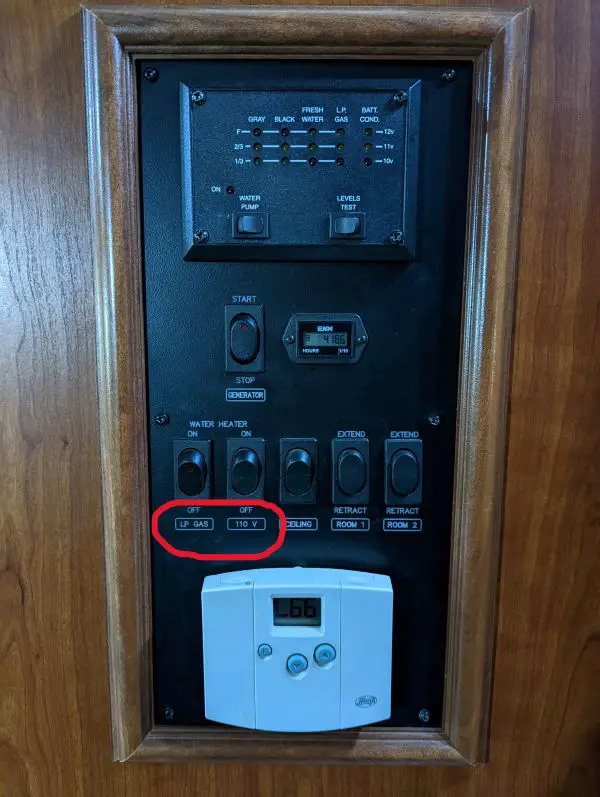
If you Are Somewhere Cold, Keep the Bathroom Door Cracked Open
Most RV bathrooms don’t have heat vents bringing warm air into the space. For that reason, the bathroom can be one of the coldest places in the entire RV. If you are camping in cool weather, you can avoid a freezing RV shower with one simple trick.
Crack the bathroom door a bit if possible. This will let some of the warm air from the rest of the RV get into the bathroom. That way, you won’t be shivering when your shower is over.
How to get hot water in the shower to last longer
If you have a water heater with a tank, chances are it is quite small. Our water heater is 6 gallons, which is pretty standard in RVs. A small water heater means the hot water can run out really fast during an RV shower.
One simple way to get hot water in the shower to last longer is to turn the hot faucet on to just a trickle. Then, add cold water to increase the pressure. Your shower water will still be plenty hot, but it will last much longer. Using this strategy, I can easily get a 10-15 minute shower.
Upgrade Your RV Shower Head
RV showerheads are notorious for having poor water pressure. One of the very first things we did when we purchased our RV (after replacing the horrid RV mattress) was upgrade our showerhead.
Depending on the setup you currently have, this task is pretty simple. For us, all we had to do was unscrew the old head and screw in the new; simple as that. Replacing your RV showerhead will make it much easier to get all the soapsuds out of your hair.
The Oxygenics Brand showerheads are a hit with many RVers and most models come with 4.5 or more stars on Amazon. Many residential showerheads will also work in RVs, but be sure to check out what your connections are like beforehand to ensure it will work for you.
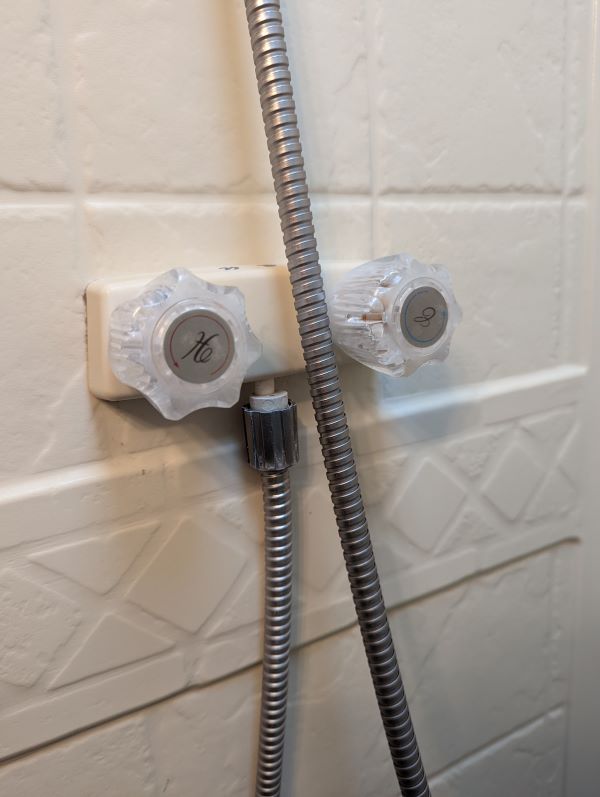
Tips For Showering Without Full Hookups
If you don’t have full hookups or are boondocking, conserving water so you don’t fill your grey tank(s) too quickly is incredibly important. Having a tankless water heater can be a drawback for boondockers since you might have to run the water for a bit before it is actually hot. However, one could argue getting the water set to the right temperature with any water heater can take a moment.
When full hookups aren’t available, the best way to shower is sometimes called a navy shower. First, get all wet and then turn the water off. Soap up and scrub with the water off. Then, only turn it back on to rinse off. It is cold, but it lets you do fun things like boondock for longer.
If you plan to navy shower, you can avoid the shock of freezing cold water by using a shower shutoff valve. Simply twist the valve to stop the flow of water while keeping the temperature knobs turned to the right place. Then, you can open the valve and you don’t have to mess with getting the temperature back to where you want it.
Joel and I recently installed one of these valves on our shower when we started doing a lot more boondocking. It makes such a big difference in conserving water so we can stay out longer without having to find a place to replenish our water supply.
There are also some RV showerheads that have a built-in shut-off valve like the one below.
Another tip we have is to collect the water that runs while waiting for the RV shower to heat up. We use a large measuring jug like this one to collect the water and use it for things like washing dishes.
Open the Vent and Turn on the Fan
Humidity can be a problem for RVs, especially in cooler weather. As nice as it feels to step out of a shower into a steamy room, this is not so nice to your RV. It is a good idea to always shower with the ceiling vent open and the fan turned on. That way, all the humid air gets sucked out of your rig.
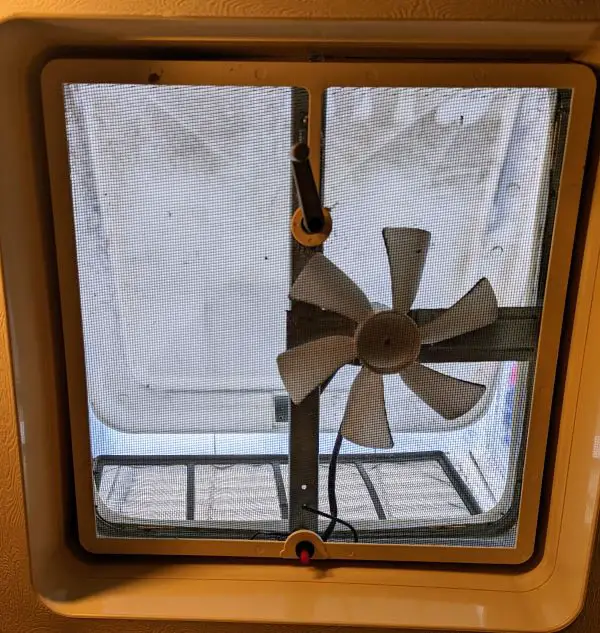
RV Shower Organization Tips
Here’s a list of helpful RV shower organization items to bring along on your next trip:
– Over the door shower caddy or tension rod shelves for storing shampoo, conditioner, body wash, and other toiletries. Because the walls of RV showers are usually made of a hard plastic material, typical suction cup mounts aren’t a good choice.
– Hanging rack or bar. These are great for hanging wet towels and storing dry towels until you need to use them.
– Shower mat or rug. This can help keep the shower area clean and dry.
– Small space shelving unit for storing extra items like extra toiletries, cleaning supplies, and more.
Remember that space is limited in an RV, so you may need to be selective about what items you bring along. However, having some way to organize your things will help make showering in an RV better.

Other Tips to Shower in an RV With Success
If you’ve ever been RVing before, you know that taking a shower can be a bit of an adventure. With limited space and water pressure, it’s important to know some tips for making the most out of your RV shower experience. After spending several years of full-time RVing, Joel and I have pretty much gotten the showering situation dialed in. Here are a few more tips I recommend you try.
The first tip is to only heat up the water for showers and otherwise turn off the water heater. This will save you energy, and you’ll still have hot water for when you need it.
If you have a separate bedroom in your rig, try changing in there instead of the bathroom. This will give you more space and privacy to get ready. If that isn’t an option, try to close all the blinds and change in the main area of your rig.
Finally, if you’re RVing in a cold location, make sure to turn up the heat right before you get in the shower. If you have electric hookups, you can even point a space heater into the bathroom for an extra blast of warmth.
Using these tips will help ensure that your RV showering experiences are as comfortable and enjoyable as possible! So next time you’re hitting the road, keep them in mind.
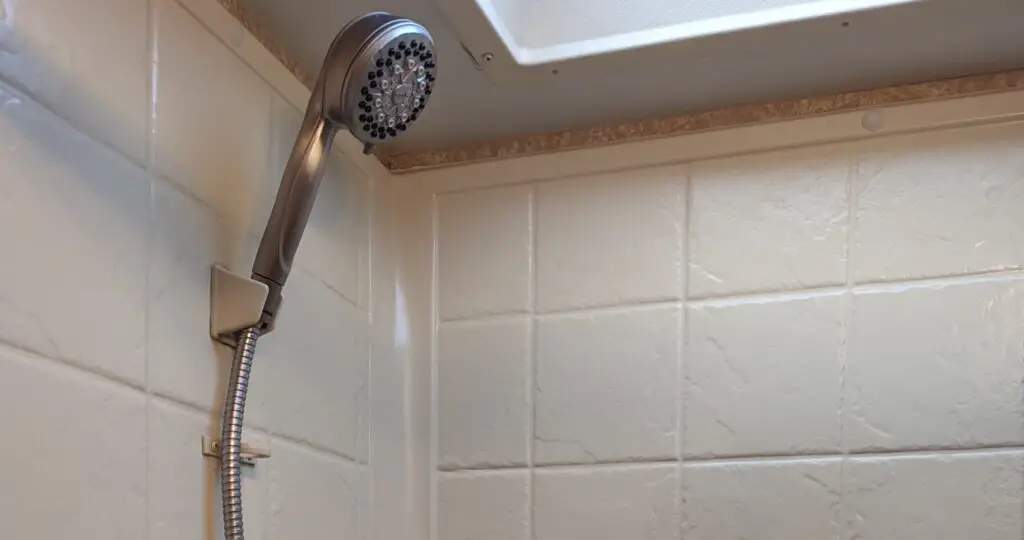
Tips for Using a Campground Shower House on Your Next RV Trip
If you don’t plan to shower in the RV, here are some tips for using a campground shower house.
1) Make sure you bring all your toiletries. You don’t want to find yourself without the items you need!
2) Bring a shower caddy with you. It may feel reminiscent of showering in a college dorm, but it makes it much easier to bring everything to and from the campground shower house. It will keep all your toiletry items tidy and organized while in the shower.
3) Don’t forget to pack a pair of sandals or flip-flops. This way, you won’t have to worry about athlete’s foot. Ew!
4) Bring your own hooks along in case there aren’t places in the shower to hang all your things up.
5) Bring a robe with you, especially if it is cold. This will give you some extra warmth while changing and drying off after your shower.

Frequently Asked Questions About Showering in an RV
Are you planning a road trip but not sure how exactly to shower in an RV? Don’t worry, you’re definitely not alone! Taking regular showers is essential for keeping clean and feeling refreshed after a long day of adventure. In this article, we’ll answer some of the most common questions about showering in an RV.
How does a Shower work in an RV?
When it comes to taking a shower in an RV, the process is only slightly different from what most people are used to with traditional bathrooms. So, how does a shower work in an RV?
First of all, water is heated up either in a tank water heater or with a tankless water heater. When you turn on the faucets, the water comes out of the showerhead as normal. If you’re wondering, “Where does water go when you shower in an RV?”, the answer is really quite simple.
The water then goes down the drain into a grey water holding tank. This is where it differs from traditional bathrooms. This holding tank can fill up when the valve is closed, especially if you have a tankless water heater and take a long shower. If the grey tank fills up, water will back up in your shower. This is why some people open the grey tank valve before a long shower to avoid this problem.
Eventually, once your grey tank is full, you will have to dump the tank. If you are staying somewhere with full hookups, this is no problem. If you are boondocking, you will need to find a dump station to dump your tanks. You can’t just dump grey water on the ground. In most places it is illegal and in all places, it is bad for the environment, so don’t do it.
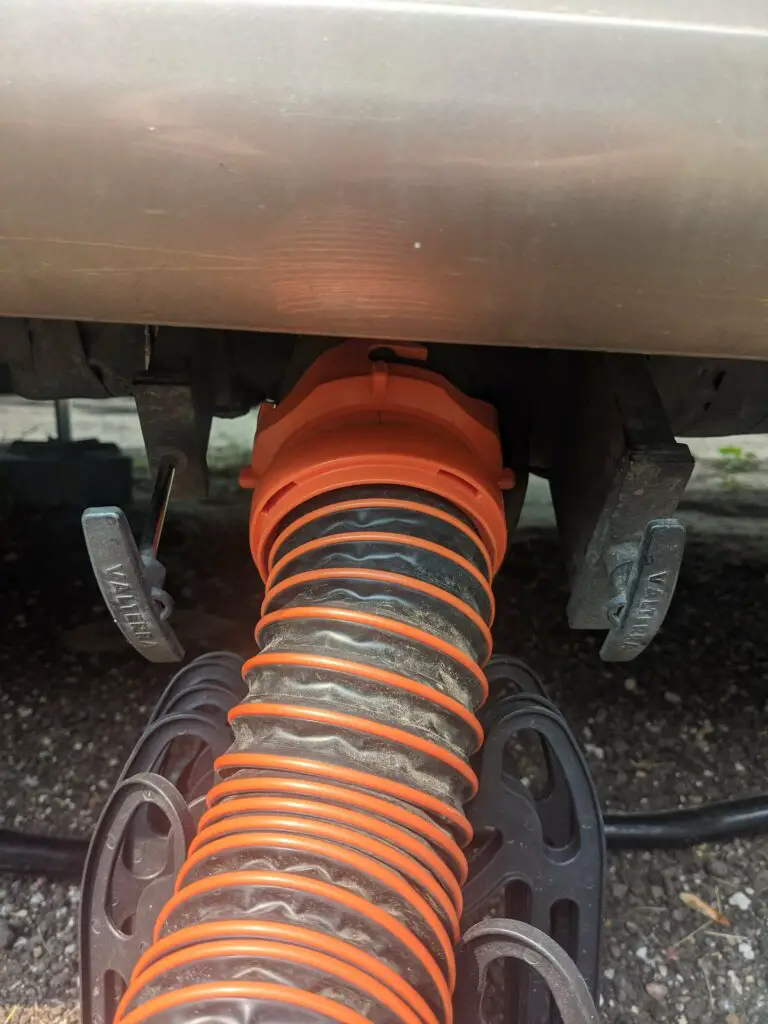
Should I Open or Close the Grey Tank Valve When Showering?
The answer to this question is, “It depends.” If you need to dump your black tank soon, it is best to leave the grey tank valve shut. This allows your grey tank to fill up with water. Then, when you dump your black tank, you will have a sufficient amount of grey water to give your hose a good rinse afterward.
If you plan to have multiple people showering in a row and you just dumped your black tank, leaving the grey valve open while you shower can simplify things. Otherwise, when your grey tank is full, the water backs up into the shower. This can easily happen when you have multiple people showering in a row.
If you notice water backing up in the shower, don’t panic. This can be alarming for a new RVer, since it isn’t something one has to deal with in a house. Usually, the cause is simply that you need to dump your grey tank. So if this happens, stop your shower as fast as possible (or shout at your partner to open the grey tank valve) and everything will be ok.
How Do you Clean a Shower in an RV?
Wiping down the shower walls and floor after each use can help keep your RV clean. It will prevent soap scum buildup and make it easier to deep-clean the shower periodically. When cleaning the bathroom in an RV, choose an eco-friendly cleaner like Simple Green or Ecos. Avoid bleach products as it isn’t good for your tanks to have bleach sitting in them since it can impact the seals. Once you’ve sprayed the walls and floor, scrub with a scrub brush.
After each shower, take a squeegee to wipe away any excess water towards the drain. When you’re done showering, leave the door open and the vent on so there’s proper airflow while drying. This will help prevent moisture build-up that can lead to mold.
Finally, for drying towels, hang them outside the bathroom rather than inside. Doing so ensures they dry more quickly and efficiently. If you keep them hanging in the bathroom, leave the door open to allow more airflow.
Moisture can have a significant negative impact on RVs so you want to minimize it whenever possible. If you live somewhere extremely humid or winter camp, you may also want to get a dehumidifier. With these simple steps, you’ll have a clean and fresh RV shower for years to come!
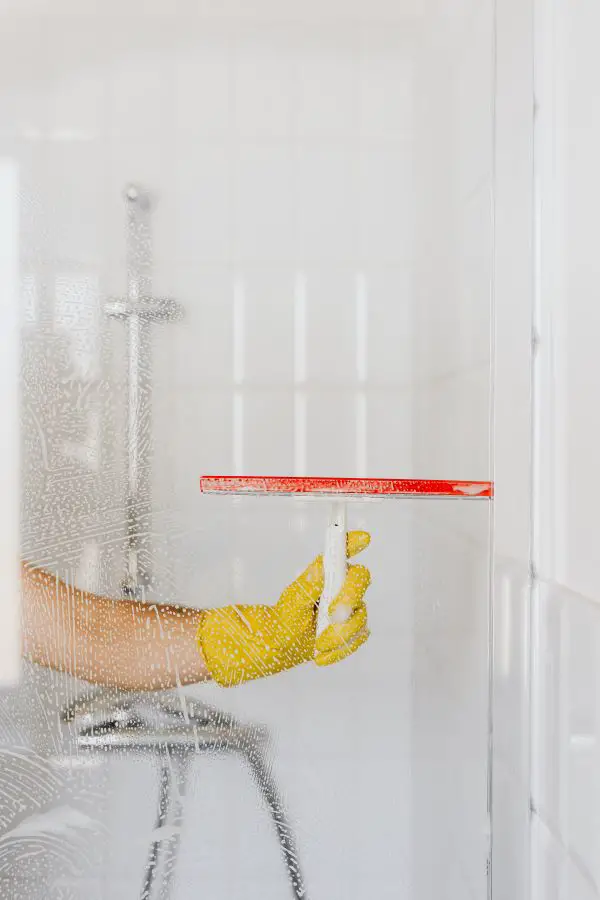
Can You Shower in an RV Without Water Hookup?
Yes, you can shower in an RV without water hookups! Most RVs come with a freshwater tank and grey tank which will allow you to shower even without full hookups. You will need to ensure you fill your fresh water tank and empty your grey water tank prior to embarking on a journey into the wilderness. You’ll also need a water heater and a water pump to make it all work.
It’s important to be mindful of water usage when you’re not connected to a water source. I recommend cutting back on your shower time or even skipping showers completely and using a washcloth and soap or baby wipes for cleaning yourself instead. Whether this is necessary will depend how long you plan to boondock.
When Joel and I got really into boondocking, I even cut my hair short and got an undercut so I would have less hair to deal with during my super quick showers. The things we do for adventure… Although now I love it!
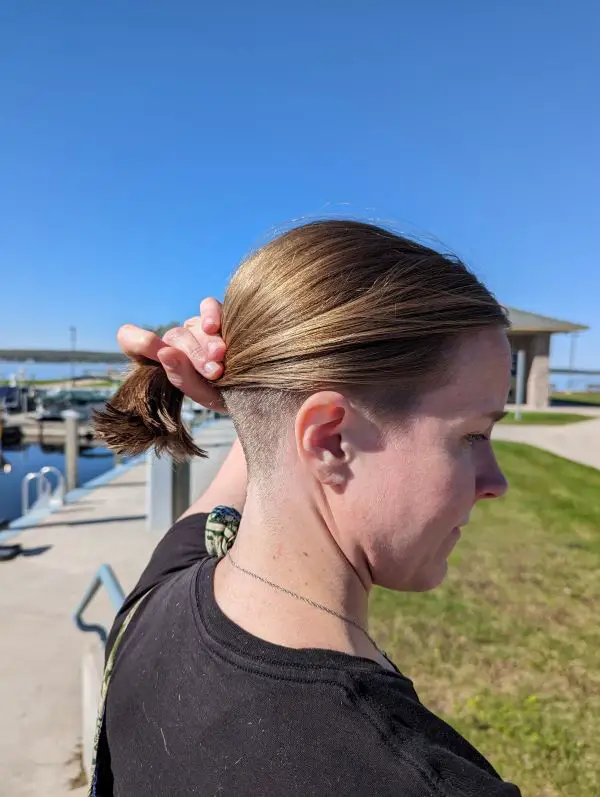
Other Tips to Shower in an RV Without Hookups
Even with all the space conservation techniques, propane typically runs out slower than water does, so you don’t have to worry as much about that. If you use electricity to heat your water and have solar power only, it is best to be cautious with water usage as heating also draws a lot of power.
You should also absolutely invest in a showerhead with an on/off switch or add your own valve. This will help you conserve water and save money on propane. For Joel and I, having the shut-off valve was a total life saver and even those few minutes of hot water felt heavenly when boondocking. All in all, it is totally possible to take showers without having a traditional water hookup!
How Much Water do You Need to Shower in an RV?
If you’re an RVer, chances are you’re an expert at conserving water. Whether you’re living in your rig full-time or hitting the open road for a few weeks each year, there’s always the challenge of using limited resources responsibly. One of those precious resources is water. That’s why it’s important to know just how much is used when showering.
When it comes to how many gallons of water are used when showering in RVs, the answer is not so simple. It depends on the type of showerhead you have and how long your showers are. For example, one popular RV showerhead—the Oxygenics Fury—uses just under 1.5 gallons of water per minute at 50 psi. That means a 10-minute shower would use 15 gallons of water, which can quickly add up if you’re boondocking or dry camping in remote areas where resources are limited.
What Else do RVers Use RV Showers For?
Some RVers use their RV showers as an extra space for additional storage. It’s a great place to store items like towels, toiletries, and other small items. Just make sure not to put anything too heavy on the floor so you don’t cause any damage!
If you get caught out in the rain or like to frequent the beach or pool, you can also use your RV shower as a drying location. Just hang your wet items up and let them dry overnight!
Benefits of Using the Shower in an RV
Showering in an RV has a lot of benefits! No more walking to and from the campground shower house or dealing with public facilities. Plus, your RV will often be warmer than the campground showers in colder weather. And if you’re boondocking, it’s still possible to take a shower, although it might have to be a quick one.
Overall, there are some downsides when you shower in an RV. For example, there may be less pressure than at home or in a campground shower house and an RV shower is typically quite small. However, the benefits may outweigh the drawbacks. You can enjoy taking hot showers no matter where you are and you don’t have to worry about trekking to and from the shower house.
Say Hello To Actually Enjoying Your Shower in an RV
Taking a shower in an RV doesn’t have to be a terrible experience. With all these tips, you can make your RV shower time enjoyable and convenient. Soon you’ll feel like you get the same great shower you would have at home. Enjoy your experience and make the most of it! After all, there’s nothing like a hot shower after a long day of camping.


